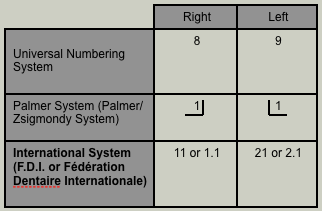
Introduction
BM Cleghorn DMD MS
Teeth can be named using either the longhand designation or using one of a number of shorthand systems. When using the longhand designation, teeth should be identified using proper terminology in a precise order. Two examples are shown below.
"Secondary maxillary right first molar"
"Primary mandibular left second molar"
These two examples are indicative of a systematic order of terms from Set (primary or secondary) to Arch (maxillary or mandibular) to Side (left or right) to Tooth (central incisor, first molar, second premolar, etc.).
Using the longhand designation each time a tooth is described would be cumbersome and time-consuming. As a result, a number of different shorthand numbering systems (or designations) have been developed to provide efficient, clear and easy methods to describe each of the teeth in the dentitions. The three most commonly used shorthand systems are described below.
The three shorthand systems that will be described are the International system, the Universal system and the Palmer or Palmer/Zsigmondy system. The table below illustrates the three shorthand designations for the secondary maxillary left and right central incisors.

Some differences that should be noted between the primary and secondary dentitions are as follows:
1. There are 20 teeth in the primary dentition as opposed to 32 teeth in the secondary dentition. 2. The primary dentition has 2 molars per quadrant while the secondary dentition has 3 molars per quadrant. 3. There are no premolars in the primary dentition. The secondary dentition has 2 premolars per quadrant (for a total or 8).